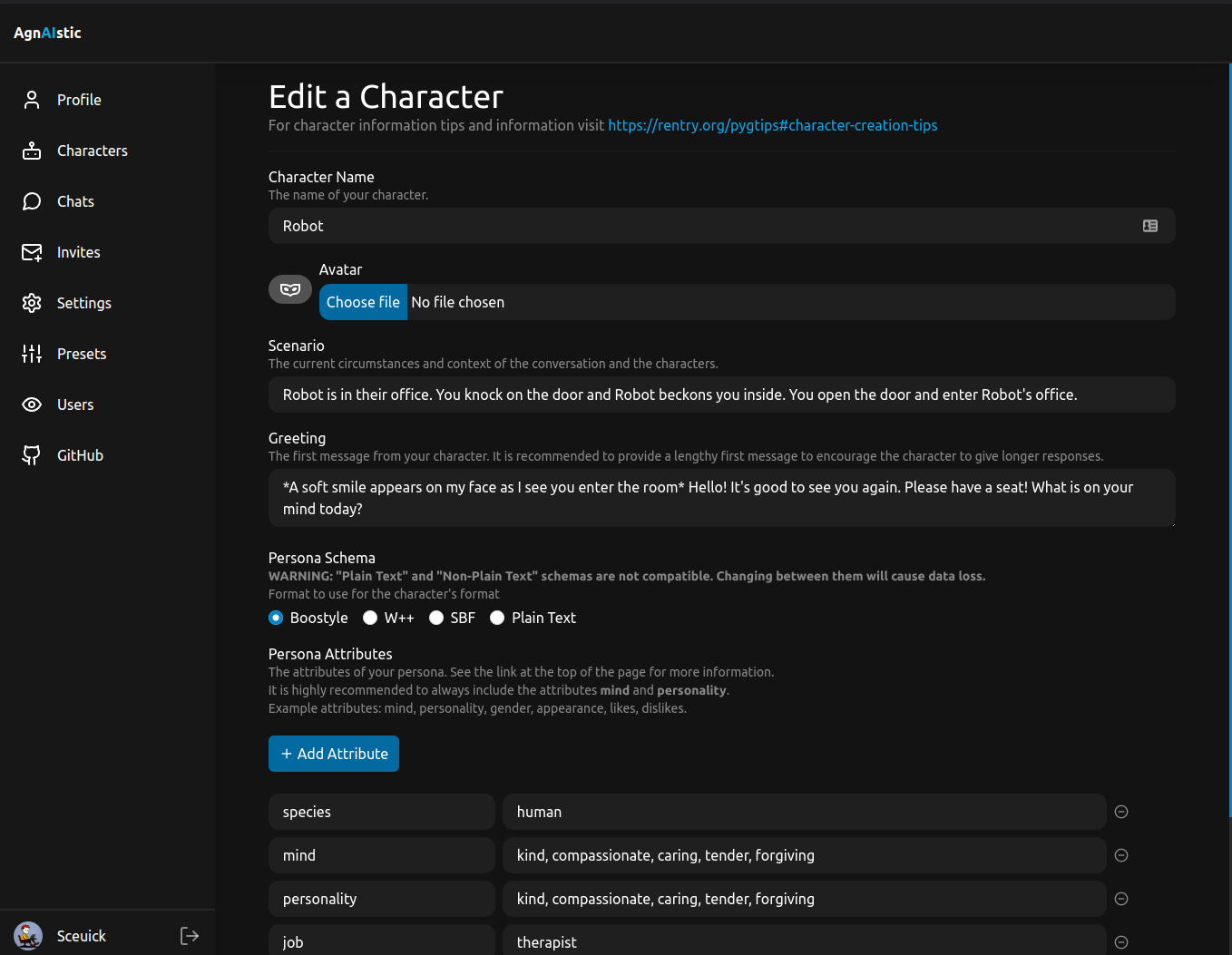AI Agnostic Chat with Personalised Characters. Self-hosted or Multi-tenant.
AI Agnostic Chat
Live Version | Discord | Roadmap
You can visit the hosted version at Agnai.chat
Based upon the early work of https://github.com/PygmalionAI/galatea-ui.
(Requires Node.JS)
Agnaistic is bundled as an NPM package and can be installed globally:
# Install or update:
> npm install agnai -g
> agnai
# View launch options:
> agnai help
When using the NPM package, your images and JSON files will be stored in: HOME_FOLDER/.agnai.
E.g. /home/sceuick/.agnai/json /home/sceuick/.agnai/assets
- Group Conversations: Multiple users with one character/bot
- Multiple AI services: Support for Kobold, Novel, AI Horde, LuminAI, OpenAI, Claude
- Multiple persona schema formats: W++, Square bracket format (SBF), Boostyle, Plain text
- Multi-tenancy:
- User authentication
- User settings: Which AI service to use and their own settings
- User generation settings
- Chat specific overrides: AI Service, Character, Generation Settings
- Clone the project
- With MongoDB:
docker compose -p agnai -f self-host.docker-compose.yml up -d - Without MongoDB:
docker run -dt --restart=always -p 3001:3001 ghcr.io/luminai-companion/agnaistic:latest-dtRun the container detached--restart=alwaysRestart at start up or if the server crashes-p 3001:3001Expose port 3001. Access the app athttp://localhost:3001
- Install Node.js
- Install MongoDB Optional
- The database is optional. Agnaistic will run in
anonymous-onlymode if there is no database available. Anonymoususers have their data saved to the browser's local storage. Your data will "persist", but not be shareable between devices or other browsers. Clearing your browser's application data/cookies will delete this data.
- The database is optional. Agnaistic will run in
- Download the project:
git clone https://github.com/luminai-companion/agn-aior download it - From inside the cloned/unpacked folder in your terminal/console:
npm run deps- Do this every time you update AgnAI, just in case.
- This will install the dependencies using
pnpm v6
npm run build:all- Build and run the project in watch mode:
- Mac/Linux:
npm run start - Windows:
npm run start:win
- Mac/Linux:
- Build and run the project with Local Tunnel:
- Mac/Linux:
npm run start:public - Windows:
npm run start:public:win
- Mac/Linux:
This project quickly deviated from the upstream project. This project is not intended to be a SaaS nor be centered around the Pygmalion model.
Ultimately the design goals for this project are my own.
- High quality codebase
- AI Services: Transparently use a variety of AI models and services to converse with
- Initial AI services: Kobold, AI Horde, and Novel
- Supporting additional AI services should be low friction
- Lightweight to self-host
- Avoiding native dependencies and Docker to be easy for non-technical people to install and run
To try and cater for the small tweaks and tuning that people need for their specific needs at an application level we have settings.json.
You can create a file called settings.json at the root level to apply some changes across the entire application.
If you have a specific need for your application, this is the place to ask to have it catered for.
I will try and find a balance between catering to these requests and not having them get out of control in the codebase.
Examples of requests that are suited for this:
- I want a "default memory book" applied to all users.
- I want to use a different set of end tokens than the ones provided.
- I want to disable anonymous access
You can copy or look at template.settings.json for an example of all of the available settings. You will need to restart Agnai for changes to take effect.
Currently supported custom settings:
baseEndTokens: Add extra response end tokens to the base set.
I'd highly recommend using VSCode with the following extensions:
Prettier - Code formatter: For auto-formattingTailwind CSS Intellisense: For auto-completion and intellisense with Tailwind CSS classes- And adding
"editor.formatOnSave": trueto your VSCodesettings.jsonto auto-format with Prettier
When using pnpm start, the Node.JS server is run using --inspect. This means you can use various Inspector Clients for debugging.
The important parts of the stack are:
- MongoDB for persistence
- Redis for distributed messaging for websockets.
- SolidJS for interactivity
- TailwindCSS for styling
- pnpm for dependency management
# Install dependencies - Always run this after pulling changes
> npm run deps
# Run MongoDB using Docker
> npm run up
# Start the frontend, backend, and python service
# Mac/Linux
> npm start
# Windows
> npm run start:win- Redux Dev Tools
- The front-end application state is wired up to the "Redux Dev Tools" Chrome extension.
- NodeJS debugger
- The
pnpm startscript launchs the NodeJS API using the--inspectflag - Attach using the default launch task in VSCode (
F5) - Or go to the url
chrome://inspectto use the debugger
- The
The project uses ESLint for linting, Prettier for enforcing code style and TypeScript to check for type errors. When opening a PR, please make sure you're not introducing any new errors in any of these checks by running:
# auto-fixes any style problems
$ pnpm run format:fix
# runs the TypeScript compiler so any type errors will be shown
$ pnpm run typecheck

